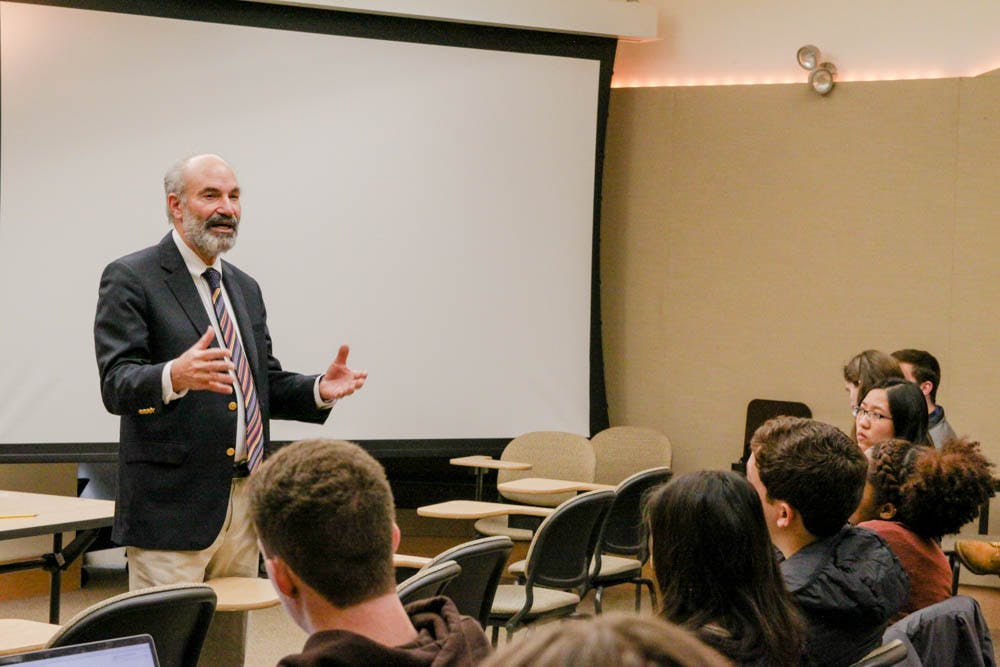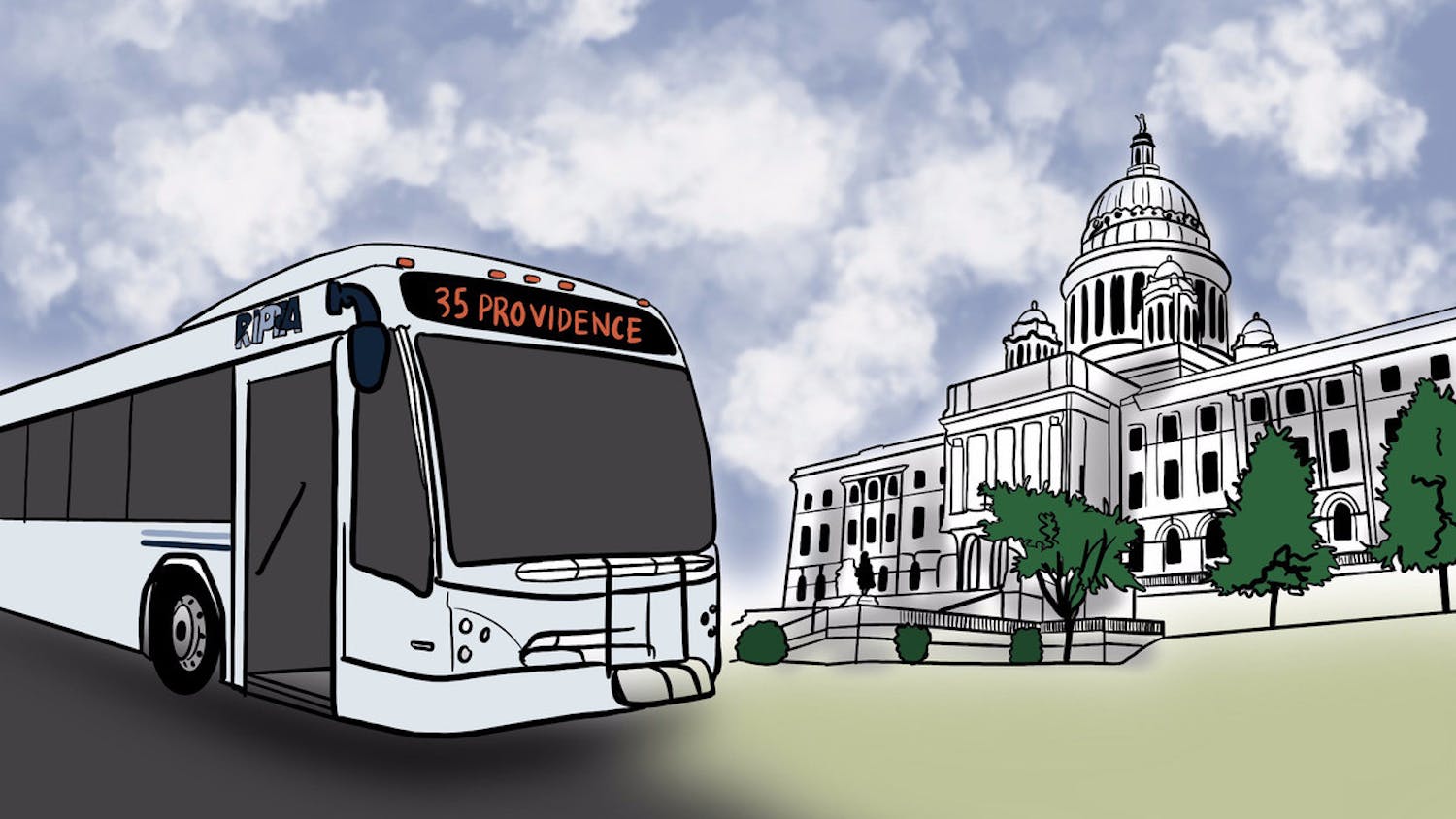Updated at 5:30 p.m. on Monday, March 26, 2018.
When Luis Estrada was released from prison Dec. 21, 2005, he had spent almost half of his life incarcerated. At 23 years old, Estrada participated in a jewelry heist worth $860,000, according to the Providence Journal, and then spent the next 22 years in prison. Estrada was imprisoned for 16 years in the federal system and six years at the Rhode Island Adult Correctional Institutions. For the first three and half years of his sentence, Estrada only spent nine months outside of solitary confinement.
“I spent two nine-month stays ‘down there,’” Estrada said, explaining that “down there” or “the hole” describe population segregation, otherwise known as “solitary confinement.”
“There’s no sunlight, no one to talk to,” he said, “It was cold. There was quite a bit of weight loss for me. In nine months, I lost 30 pounds.”
Estrada explained that measuring those personal changes was difficult. It was only until he had to “put on court clothes” that he realized how much weight he had lost. “You’re not noticing that you’re getting pale … that you fatigue easily,” Estrada said.
“I came out more stubborn,” he said.
In “the hole” and out again
When Estrada was in the R.I. ACI, he said that there were inmates kept in solitary confinement for extended periods of time. In both Rhode Island and across the country, prisons have been grappling with this issue, questioning the value of solitary confinment.
It was an “institutional rumor” that John Carillo had his door welded shut during confinement, Estrada said. Carillo, who killed R.I. Correctional Officer Donald Price in 1973 during a prison riot, was dubbed “Rhode Island’s most dangerous inmate” according to the Providence Journal, and was eventually released from solitary confinement in 1980 after he sued the R.I. ACI. Carillo had been spending 23 hours a day in his cell for more than eight years.
“What made that case different was that he killed (a correctional officer). It was horrible what was happening in that case,” said Robert Mann, the lawyer who represented Carillo. Mann still practices criminal defense in R.I. “My sense is that it is not as bad as it was 25 to 30 years ago,” Mann said. He still believes that the state overuses situations that put inmates in limited contact with other people, calling himself a “bleeding heart liberal.”
In the Carillo case, Mann said that the courts avoided deciding on the constitutional issue of solitary confinement and instead ruled that the R.I. ACI violated Morris Rules. Established in 1983, the Morris Rules were formed out of inmate litigation and negotiation in R.I. and outlined specific procedures for stays in population segregation, according to the case records.
While Mann believes that the R.I. ACI is now imposing shorter segregation periods, he said there is a “semantic argument about what constitutes solitary,” and that there should be a “push to get rid of solitary.”
Chief of Information and Public Relations Officer for the R.I. Department of Corrections J.R. Ventura says that there are always ways to improve the system and that there are “concerted efforts to make sure we are consistent in our treatment,” adding that, “the way we address discipline is always evolving.”
Estrada said that the period he spent in solitary confinement allowed him to reflect and to get sober. “Thirty-one years Feb. 28th, clean and sober,” he said.
Today, Estrada is the office manager of a law firm, has four college degrees and, in his own words, has turned his life around. As a sitting board member of OpenDoors, a group that aids reentry into the community for the formerly incarcerated, and several other community groups, Estrada says he sits on a board with a man who once denied him parole five times.
Rhode Island’s prison confinement policies and practices
“There’s been serious issues in Rhode Island with the use of solitary confinement,” University of Pittsburgh Law Professor Jules Lobel told The Herald. Lobel has challenged the legality of solitary confinement for decades.
“I think the Rhode Island Director of Corrections is trying to perform, trying to change them. Rhode Island has overused solitary in the past and has kept people in poor conditions,” Lobel said. The system “could use more due process.”
Prisoners who are found guilty of a disciplinary infraction can be placed in disciplinary confinement for zero days to a year, wrote Susan Perez, programming services officer at the state of Rhode Island Department of Corrections, in an email to The Herald. To receive more than 30 days of of disciplinary confinement, an inmate must have “caused serious injury, immense damage, or posed a severe threat to institutional or public safety,” she wrote.
To prisoners, a 30-day segregation period is called a “rest” — a vacation from the constant pressure that looms over inmates, Estrada said. “That’s only a sleepover.”
When legislation or policies have been suggested to decrease any segregation period to only 30 days, Estrada says he’s questioned if that’s the right number. “Department of Corrections’ job is extremely difficult,” Estrada said. “(They) only have two really effective tools: to deter or encourage.” Inmates can either be offered “good time” for good behavior, education or work, which shortens their sentence, or they can receive punitive measures.
“The biggest problem is inmate-on-inmate violence,” Estrada said, adding that for some inmates, particularly those serving a life sentence, the only way to prevent this violence is through segregation.
Ventura agrees that safety is of the highest priority inside. He says that “closed confinement” and “administrative confinement” are not punitive measures — as opposed to solitary confinement — but measures to keep the population and staff safe. Inmates in administrative confinement are reviewed at a frequency of no more than 90 days, Perez wrote.
According to Ventura, R.I. uses a “step down” system, which means that inmates in disciplinary confinement go in front of a board every 30 to 60 days to review why they are in segregation and whether their behavior has changed, so they can return to the rest of the population.
The placement of prisoners in disciplinary confinement can be reviewed whenever the staff suggests it, or the inmates can request a review after 45 days, Perez wrote. Their time in disciplinary confinement may be suspended if behavioral changes are shown.
“I don’t know enough about the Rhode Island program, but I think a step down program, which is relatively short, which really gives people incentives to move out of solitary, is a good thing,” Lobel told The Herald. “Some step down programs are good and some are just continuing to warehouse people.”
Rhode Island’s disciplinary confinement cannot be deemed “solitary,” according to Ventura. “The notion of solitary confinement presents a picture of no human contact,” Ventura said. “Even the most egregious of offenders … a person that will throw feces … or attack an officer, even those people have contact with officers and counselors,” he said.
Inmates who experience serious mental health issues are evaluated by mental health staff and placed in the Residential Treatment Unit if they receive disciplines or show recurring misbehavior, Perez wrote. They are not placed in disciplinary or administrative confinement.
Solitary Confinement in the United States
Outside of R.I., Lobel has battled against the use of solitary confinement, including the Pelican Bay State Prison class action lawsuit. Lobel sought to change the California prison’s solitary confinement practices in their “Security Housing Unit,” Lobel explained at a talk hosted by the Center for Prisoner Health and Human Rights and Brown’s chapter of the American Civil Liberties Union March 8.
Cells in Pelican Bay’s SHU were 80 square feet, “twice as big as the average American walk in closet.” Inmates in the SHU were allowed one half-hour exercise period each day, with no equipment. There were no programming or religious ceremonies for prisoners. Family visits were done through glass barriers. The prison’s location on the California-Oregon border was isolating and prevented many families from visiting altogether, Lobel said.
Many of those in the SHU were linked to or associated with prison gangs. “California considered gangs to be as evil as … terrorists,” Lobel said. To leave the SHU, Lobel said inmates had to get parole, die or become informants. Often, informants were kept in similarly isolated situations; Lobel described the situation as a “Catch 22.”
“When I think about how long I could last in (solitary confinement), I would give myself a couple of weeks, maybe a month — not ten years, as hundreds of people were subjected to,” Lobel said.
Making the argument that “people have a basic need for human interaction,” Lobel and his colleagues asserted that the deprivation of basic rights in the SHU constituted cruel and unusual punishment. Two hunger strikes and years of litigation led to a settlement that “removed virtually everyone” from that kind of solitary confinement, Lobel said. He credits the sweeping victory to several previous lawsuits.
Both before the Pelican Bay Case and ever since, Lobel says his own struggle against violations of civil liberties and human rights has often involved losses. “One of my claims to fame is that I’ve sued every President (since Reagan) up until the current one — who I’m itching to sue,” Lobel said, adding that even among those cases, a win does not always culminate in action.
“As I speak here today, there are 100,000 individuals in solitary confinement,” in the United States, Lobel said. He is currently working in Pennsylvania to change rules and regulation there. Ohio and New York have already passed solitary confinement laws, but it is still a major issue in the United States, Lobel added.





